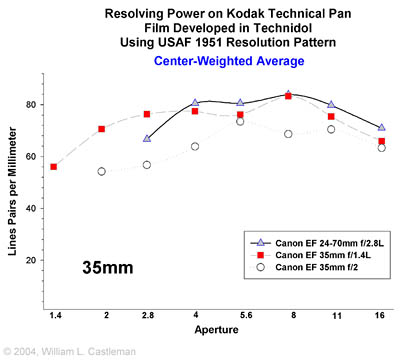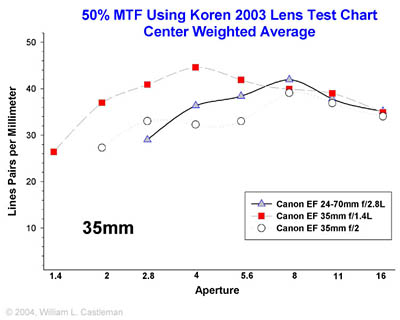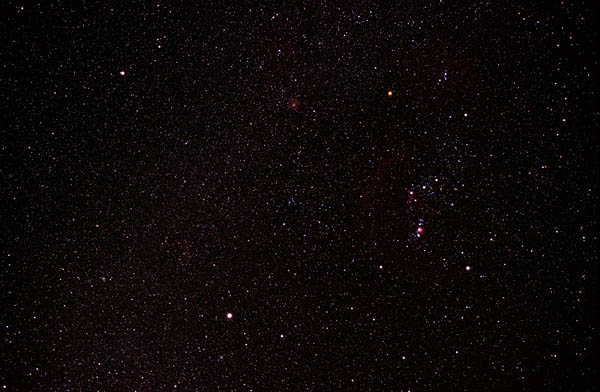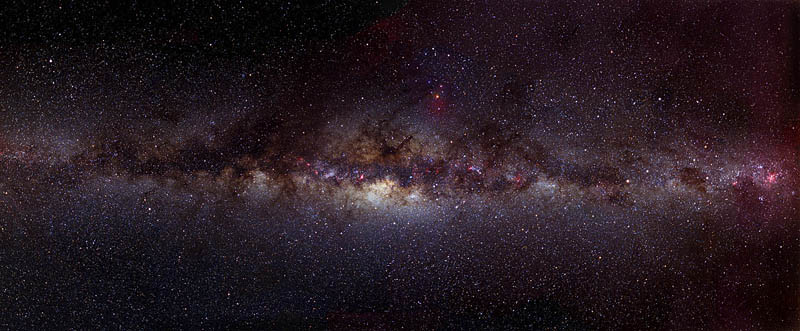Evaluation
of the Canon EF 35mm f/1.4L USM Lens
Resolution and 50% MTF Performance
Data
Link
to Methods Used
 |
 |
| The Canon EF 35mm f/1.4L substantially outperforms the f/2 consumer lens from f/2 to f/4 in both resolution and microcontrast (MTF). | |
Linear Distortion
The EF 35mm f/1.4L, EF 35mm f/2, and EF 24-70mm f/2.8L at 35mm were all free of significant linear distortion (e.g., barrel or pin cushion). This is more signficant for architectural photography than for other applications.
Light Drop Off (Vignetting)
The EF 35mm f/1.4L, EF 35mm f/2, and EF 24-70mm f/2.8L at 35mm all have significant light drop off from the center when shot at wide-open aperture. The table summarizes how image field illumination evens as aperture is closed.
| Aperture | EF 35mm f/1.4L | EF 35mm f/2 | EF 24-70mm f/2.8L |
| Wide Open | f/1.4 Moderate |
f/2 Moderate |
f/2.8 Mild |
| One Stop Closed | f/2 Mild |
f/2.8 Mild |
f/4 Negligible |
| Two Stops Closed | f/2.8 Negligible |
f/4 Negligible |
f/5.6 None |
Corner Image Sharpness and Chromatic Aberration with EOS-1Ds
Image sharpness and lateral chromatic aberration (CA) varied among the lenses tested. Mild lateral chromatic aberration in the far corners of images is a common finding in wide angle lenses used with the EOS-1Ds. Examples below in the table are from the far left upper corner of this chart.
| Aperture | EF 35mm f/1.4L | EF 35mm f/2 | EF 24-70mm f/2.8L |
| Wide Open | f/1.4 Soft, Mild CA |
f/2 Very Soft, Mild CA |
f/2.8 Sharp, Mild CA |
| One Stop Closed | f/2 Intermed. soft, Mild CA |
f/2.8 Soft, Mild CA |
f/4 Sharp, Mild CA |
| Two Stops Closed | f/2.8 Slightly soft, Mild CA |
f/4 Soft, Mild CA |
f/5.6 Sharp, Mild CA |
Center Image Sharpness with EOS-1Ds
Central image sharpness varied among the lenses tested. There was no central chromatic aberration. Examples below in the table are from the center of this chart.
| Aperture | EF 35mm f/1.4L | EF 35mm f/2 | EF 24-70mm f/2.8L |
| Wide Open | f/1.4 Sharp |
f/2 Mildly Soft |
f/2.8 Sharp |
| One Stop Closed | f/2 Sharp |
f/2.8 Slightly soft |
f/4 Sharp |
| Two Stops Closed | f/2.8 Sharp |
f/4 Sharp |
f/5.6 Sharp |
Coma
As with all fast wide angle lenses, the EF 35mm f/1.4 L shows significant coma in edges of the field when shot at f/1.4 or f/2. These aberrations are almost completely corrected by stopping the lens down to f/2.8.
| A widefield photograph taken at f/2.8 at
the right shows Orion and Monoceros with the bright stars Procyon,
Betelgeuse, Rigel and Sirius in the field. Click on the photograph to
see a large field view of other features including the Great Orion
nebula, Horsehead nebula area , Flame nebula and Rosette nebula. (Click
here
for labeled astrophotograph). Compare with stellar aberrations (mostly coma) at: Full size astrophotos are 500-780 kbytes each |
 Orion and Monoceros with Sirius at bottom of field Canon EF 35mm f/1.4 L at f/2.8 for 5 minutes Kodak Elite 200 film pushed 1 stop Camera mounted on polar aligned Losmandy GM-8 for unguided exposure March 10, 2005, Chiefland FL |
The EF 35mm f/1.4 L lens has significantly better sharpness (resolution and MTF) from f/2 to f/4 than the EF 35mm f/2 lens. Corner sharpness is very good if stopped down. The EF 35mm f/1.4 L is an excellent fast lens for wide field astrophotography and performs optimally at f/2.8. It is also a fast focusing lens when used for general photographic purpose. Performance is excellent at f/2 for non-astro photography.
 Astrophotographs with the EF 35mm f/1.4L at the 2005 Queensland Astrofest |
©
2004-2005, W.L. Castleman
Initially
posted 5 December, 2004; Last updated 23 March, 2005